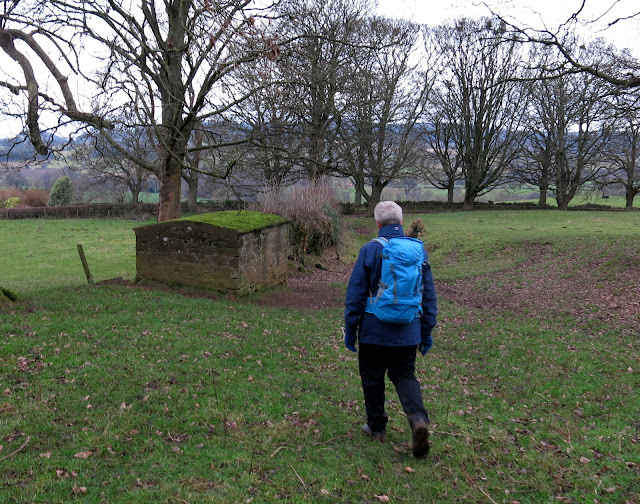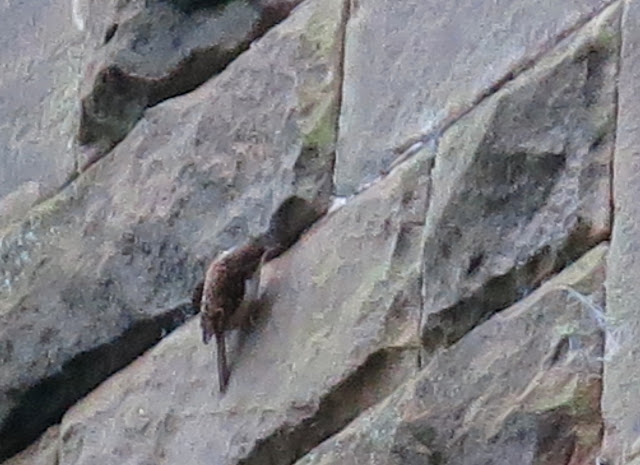5 miles Cold and grey
We parked at Over Silton at the roadside opposite the Old School House, having approached the village from the A19, for this short walk, our first of 2020.
 |
| Today's walk from The Walker's Guide to the Hambleton Hills |
 |
| The Old School House |
 |
| Manor House |
Tom Scott Burns notes that the name Silton probably derives from Sal as in Upsal, which means Hall, and Ton, which is old Anglian for place or town.
We followed the road out of Over Silton and turned into a field at a gate. Although easy to miss, there is a way-mark on the telegraph pole here, but we found that with much of today's route, whilst shown on the map, its tracks that cross fields are hard to see.
 |
| Walking out of Over Silton - turn off at telegraph pole |
 |
| Walking towards Greystone Farm |
We walked through fields until we reached Greystone Farm, passing by the attractive and tidily kept buildings to see a small open barn full of rosettes and prize certificates.
 |
| Sign at Greystone Farm |
 |
| Greystone Farm |
 |
| Prize rosettes for the Silton Flock |
 |
| Pegigree Suffolks |
 |
| "There's no need to stand up..." |
The route continues along field paths until reaching Nether Silton where we crossed the road and and rejoined our path which led us to Hall Farm.
 |
| The green at Nether Silton |
 |
| Clive looks over to spot our return path at Nether Silton |
 |
| Hardy Welsh cattle at Hall Farm |
 |
| The gaffer at Hall Farm |
 |
| Game pens at Hall Farm |
We continued beyond the farm to walk through sodden fields until we reached the footbridge over Sorrow Beck.
 |
| Wet field tracks and a new footpath sign |
As we approached the pond near Sorrow Beck I spotted a heron and crept closer to take a photo.
 |
| What a great catch! |
As we neared the bird it remained suspiciously still and we were left wondering who had planted a model heron by this remote pond? Never mind, it gave us a laugh.
 |
| "It's so still you could almost believe it isn't real..." |
 |
| Sorrow Beck |
After crossing the beck we walked through fields to reach a stone footbridge that is built over what used to be a 3.5 mile narrow gauge railway. Constructed in 1833 this railway brought limestone mined near Kepwick to kilns near to the Yarm and Thirsk turnpike road. We crossed another field and joined Peasland Lane which we followed for a mile into Cowesby.
 |
| Footbridge over dismantled railway |
 |
| Following the road into Cowesby |
 |
| Sheep enjoying turnips with Cowesby behind |
 |
| First glimpse of Cowesby Church |
 |
| Geese in field at Cowesby |
The first building we came to on entering Cowesby was St Michael and All Angels Church. The door was unlocked and we spent a few moments exploring the old building which was a bit cleaner and brighter than on our last visit, although still suffering from the effects of damp.
 |
| St Michael and All Angels |
 |
| Still suffering from damp |
After looking round the old church we took a couple of chairs outside to sit and enjoy our coffee and scones al fresco.
 |
| Any biscuits left? |
 |
| The rear of the church |
 |
| We watched the vertical antics of a tree creeper on the church wall |
Although the present church dates from only 1846 it replaced one of the oldest churches in the district, which stood on a Saxon site. We wondered if the many carved heads are modern or rescued from the old church.
The tower has an unusual pyramid roof which houses a ring of six bells, their ropes dangling near the altar.
We walked through Cowesby, past Home Farm, then followed a path bearing left along the western shoulder of Pen Hill. This path then leads down towards Kepwick.
 |
| Kepwick |
 |
| Passing Corner House in Kepwick |
 |
| Owl weather vane |
 |
| Kepwick |
 |
| Turn left here, off the main track |
 |
| Looking down on Kepwick |
 |
| Climbing Pen Hill |
TSB mentions that a John Henry Warner constructed two reservoirs on the moors above Kepwick in 1873 to supply water to Kepwick Hall and we came to an old stone building with the remains of a large metal pipe in its floor. We have previously speculated that this must be something to do with Warner's reservoir system.
 |
| Water pipe? |
We didn't enter Kepwick but instead crossed the road to re-enter fields which took us first to the disused railway and then to Bridge Beck which we crossed on a new bridge. A hundred yards later we reached and crossed Sorrow Beck.
 |
| Old railway bed |
 |
| Waymark sign moved from fallen post to new location! |
 |
| New bridge over Bridge Beck |
 |
| Then over Sorrow Beck |
 |
| Two hares in this field, can you spot them? |
We saw two hares jumping playfully about in a field a few hundred yards away. Sadly I dropped my new zoom camera on our last walk and it is awaiting repair so I took a couple of photos with my old Canon and cropped them as best as I could.
 |
| "Take a run at it!" |
 |
| Loose post then a ditch make a tricky crossing |
Back in pathless fields where way-marks are few and far between, but one should head for the outskirts of Nether Silton and the old Manor Stone which is in the middle of a field next to the 16th century manor house. The stone is cryptically inscribed with letters whose meaning I've set out below the photograph. This inscription was the idea of a Squire Hicks to mark the spot where the medieval manor house once stood.
 |
| The old manor house at Silton |
 |
| Rear of the manor house |
 |
| The Manor Stone and All Saints Church behind |
 |
Here The Grand Old Manor House Stood
The Black Beams Were Oak, The Great Walls Were Good
The Walls At The East Wing Are Hidden Here
A Thatched Cottage Like A Barn Was Erected
Year AD 1765
A Wide Porch Spans A Yard And Alcove
|
A few steps took us to the church of All Saints which is open to visitors.
 |
| All Saints Church, Nether Silton |
All Saints is a chapel of ease which was rebuilt in 1812. Such a chapel is built for the convenience of parishioners who would find it difficult to access the main church, in this case isolated St Mary's which we would pass by shortly.
Tom Scott Burns explains that wood used in the altar rails and other refurbishments were presented by a R M Jaques, and were from HMS Dreadnought of Lord Nelson's day. This chapel was in far better repair than the church at Cowesby.
 |
| Inside All Saints with altar rails and timber from HMS Dreadnaught |
 |
| Modern altar window |
After wandering round the graveyard and reading some of the cheering Victorian epitaphs we left the church and immediately turned off the road at a white gate opposite, just near to the post box. At last someone has affixed a yellow waymark sign to the gate leading to the narrow passage that takes us between houses to open fields.
 |
| A hidden passage no more, someone has affixed a sign! |
Once in the fields we were now returning to Over Silton and walking parallel to Greystone Farm and its Suffolk sheep.
After crossing the tarmac of Kirk Ings Lane we reached St Mary's Church, which appears abandoned in the middle of a field, positioned some distance from the village of Over Silton.
 |
| Suffolk sheep near to St Mary's Church |
 |
| The ram has a belt which will contain a marker |
As we approached St Mary's we saw that it looked different. Not a trick of the light, St Mary's has recently been re-roofed with fine honey coloured slates.
 |
| A new roof! |
 |
| How it was on previous visits, damage to walls and a subsiding roof |
 |
| Sections of wall have been rebuilt |
We entered the church to see that the repairs had been funded by the lottery. Money well spent, for once, we thought!
 |
| Clive checks the new roof |
 |
| A tasteful renovation |
A short walk across fields took us back to the pretty village of Over Silton which, sadly, does not have a pub, necessitating a short drive to the flesh pots of Osmotherley where we discussed our day's walk over refreshment.
 |
| The end of the walk |
 |
| Happy New Year! |







































































